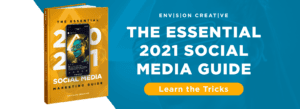I have a hunch that I’m not the only one at Envision who feels this way: brainstorming sessions are the best. With no specific agenda other than to think of ideas, group brainstorms are fun and free-flowing. To someone standing on the other side of the door, it might seem like we’re having a little too much fun. (I mean, can work really be productive if you’re enjoying yourself? Yes. Yes it can.) Over the years, through trial and error, we’ve identified our own elements of a productive creative brainstorming session. While our tips do work best for creative work, there’s plenty to borrow even if you’re putting your heads together for something that feels “more serious.”
Let it all flow
Anything freakin’ goes. Brainstorming sessions aren’t the place for final, curated, ready-to-go ideas. It’s the place where those things begin.
How to do it:
- Say random words. Seriously, blurt out anything tangentially related to your subject matter that pops into your head. Embrace free association and let those words lead to other words. Don’t. Stop. Talking.
- Talk out of turn. Unless, of course, someone is elaborating on an idea, allow all participants to speak whenever a thought strikes them.
- Be cliche. Blurt out trite phrases and existing taglines to “get them out of the way.” Searching for taglines for a jewelry company? Say “Every kiss begins with Kay” so it’s out of everyone’s head. Now you can move on.
- Ask “what if?” Explore vague, nebulous, completely undeveloped concepts. It doesn’t matter how practical they actually are. That decision comes later.
- Write everything down. Keep track of as many ideas as you can on a Google Doc or whiteboard that everyone can see.
Create a safe space
In order for our previous piece of advice to work, brainstorm participants have to feel comfortable in the space. Brainstorms filled with self-consciousness and hostility won’t amount to much.
How to do it:
- Be curious. Follow up your peer’s ideas with questions that indulge and explore the idea further. (“Okay…so so are you imagining that the hawk would be wearing human clothing, or nothing at all?”)
- Ban self-deprecating language. No need to preempt ideas with, “This is dumb, but…” or “This probably won’t work…” Most of it will be dumb. Just say it anyway. No judgement.
- Riff off of each other. Before immediately moving on to a new idea, see if you can add onto an existing idea first.
- Never, ever shame. Even if someone’s idea is literally the worst thing you’ve ever heard, hear it and write it down. Nothing kills creativity like damaging the safe space.
- Show excitement. If you like where someone is going, show it. Nurture a dynamic, energetic environment.
Don’t pressure. Creativity comes when it comes. Don’t ask participants, “So Sharon, what are your ideas?” No one should feel like they’re being tested.
Embrace the pre-brainstorm brainstorm
Depending on the project, it may not be best for the group brainstorm to start with a completely blank slate.
How to do it:
- Have some alone time. Well before the scheduled brainstorm session, task one, a few, or all participants with coming up with free-form ideas. (The same rules: anything goes. The shower is a great place to start. Go in there alone, though.)
- Take five. If no one was tasked with brainstorming ideas ahead of time, set a timer for exactly five minutes at the beginning of the session and let everyone go wild on a piece of paper. Doodles count.
- Team up. Break down participants to brainstorm one-on-one. Pair people who are likely to riff well off of each other OR pair those with different and complementary strengths.
- Divide and conquer. Before the brainstorming session ends, task groups or individuals with fleshing out specific ideas further and reconvene later.
Make it a priority
If you have any control over it, brainstorm sessions shouldn’t be the result of a “Quick! We need ideas!” situation. Good ideas take time to develop and evolve.
How to do it:
- Start early. Start brainstorming as far out from when the finished product needs to be ready as possible. Creativity isn’t something you can just “get done.” Pressure rarely works in this case.
- Save everything. You know how we said to write everything down? Never delete anything either. Old bad ideas might be great new ideas for a future project. Open up your old Google Doc and start there.
- Don’t pencil it in. The best brainstorming sessions aren’t “squeezed into” your busy schedule. They’re a valuable part of it and they should be treated that way.
- Welcome everyone. While there can be too many cooks in the kitchen later, the initial brainstorming session should welcome everyone who’s ready to offer their energy.
The most important thing of all: don’t take yourself too seriously, but see the potential in everything. You wouldn’t believe where some of our award-winning stuff started. (Really, though.)
-FINAL(01-00)-White&Blue-01.svg)





